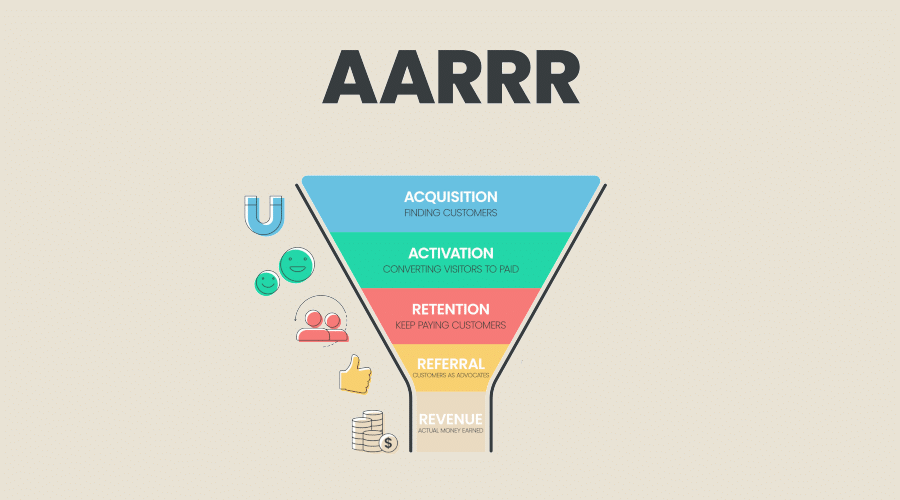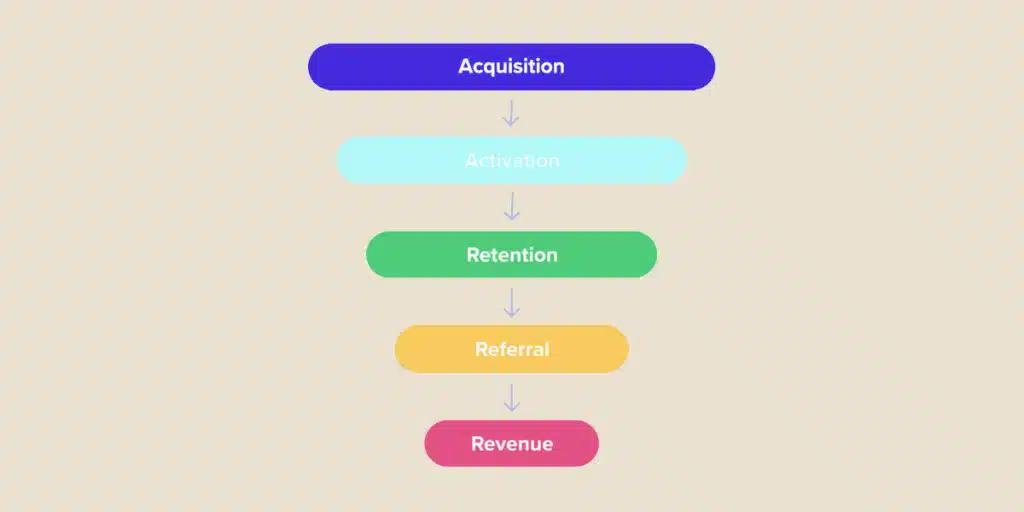The aim of any profit-making organisation is to increase its sales. To achieve this, there are a multitude of marketing strategies and campaigns. All along the customer journey. But to optimise your revenue over the long term, you need to implement the right strategy (and not just increase your conversion rate at a given point in time). That's where the AARRR framework comes in.
What is AARRR?
AARRR is an acronym for the 5 stages in the customer or user lifecycle. These are: Acquisition, Activation, Retention, Recommendation and Revenue. This framework, developed by David Mac Clure, was designed to help organisations increase their revenues.
The aim is to identify the various actions that have a positive impact on the business. The ultimate aim is to optimise the conversion rate, and therefore the brand’s revenue.
Originally, this way of thinking was mainly used by start-ups. But its relevance has made it one of the frameworks most widely used by marketing and growth hacking professionals.
💡Related articles:
What are the stages in the AARRR framework?
Acquisition
The first stage of the AARRR concerns the various acquisition channels that enable an organisation to make itself known (subscriptions to social media, visits to a website, listening to a podcast, downloading an application, etc.). To do this, companies have a multitude of tools at their disposal, such as natural referencing, inbound marketing, advertising, affiliation, emailing and so on.
But it’s important to select the right channel. So how do you go about it? Here are the different criteria to consider:
- The cost of acquisition: for example, for an SEA strategy, you need to take into account the cost per click (CPC), which can have an impact on the return on investment.
- Time spent: on the other hand, natural referencing is less expensive, but takes longer to bear fruit.
- Acquisition volume: the aim is to acquire as many new customers as possible.
- Effectiveness: optimising the three parameters mentioned above will produce the best conversion rate.
Good to know: At this stage, it’s vital to define your target clearly in order to take the most effective action in terms of conversion. There’s no point in aiming for a very large audience, at the risk of wasting time and money for an average conversion rate.
Conversely, a smaller, more targeted audience is of greater interest. To achieve this, companies need to be able to answer a number of questions: Who are their ideal customers? Where are they? What motivates them? What makes them doubt? etc.
Activation
The idea is to provide users with an unforgettable experience so that they discover the real added value of your offer. This is known as the “Aha moment”. Ideally, this Aha moment occurs as quickly as possible in the conversion tunnel.
To achieve this, you need to define an activation rate that measures the user’s degree of interest. Here are a few examples of indicators: the number of pages visited, the time spent on the site, the number of clicks, subscribing to a newsletter, adding an item to the shopping basket, etc.
At this stage of the AARRR framework, the aim is always to improve the user experience in order to encourage people to move on to the next stage. A bad experience often means the failure of the conversion strategy. If the user leaves, they will probably never come back.

Retention
This is one of the most important stages in the AARRR process, as it involves retaining and bringing back customers. For example, a customer who buys another of your products, who continues to use your services after an initial trial, and so on.
This is all the more difficult in an increasingly competitive world. Consumers are faced with a multitude of options.
To the point where it’s sometimes difficult to choose the right one. So to maintain contact with their customers and convince them of the benefits of their solution, companies have every interest in implementing an emailing strategy.
If the retention rate is poor, the previous steps will be of little use. And with good reason: acquiring new customers is much more expensive (between 5 and 25 times more) than retaining existing ones. Retention is therefore one of the steps in the AARRR process on which companies should focus a large part of their efforts.
Referral
This is recommendation. At this stage of the AARRR framework, customers are no longer just consumers of the brand, but also ambassadors. They recommend the brand to their friends, family, colleagues, etc.
Thanks to these third-party recommendations, prospects quickly develop confidence in the brand’s products or services. This is particularly interesting in the acquisition phase, as it reduces costs.
But to encourage customers to become ambassadors, recommendation programmes need to be developed. In particular, by offering benefits (discounts, free delivery, free product, etc.) to existing customers for each new customer acquired through them.
Good to know: Referral can also be placed after Revenue. That said, as generating sales is the ultimate objective of any business, we have preferred to place it at the end.
Revenu
This is the turnover generated by all the stages mentioned above. In principle, it’s the money made from a sale (of a product or service). But beware: for some businesses, it is more difficult to measure revenue. For example, for content creators, it’s the number of subscribers that determines the potential for advertising and sponsorship.
Generally speaking, revenue is linked to :
- The lifetime value of a user: what a customer brings in over the entire lifecycle.
- The cost of acquisition: this needs to be optimised to improve margins.
- Price: here again, this helps to increase margins without impacting acquisition or retention. But be careful to strike the right balance.
For all these AAARR stages, monitoring indicators is absolutely essential. You can use data from your CRM, Google analytics for websites, social network statistics or emailing tools.

Key facts:
- AARRR is a framework covering the 5 stages of the customer lifecycle.
- These are acquisition, activation, retention, referral and revenue.
- For each of these stages, the aim is to put in place the most effective actions to access the next stage, and above all, to increase the organisation’s sales.










